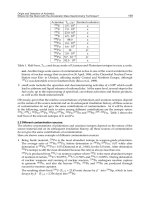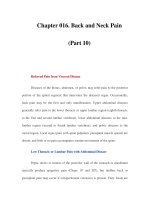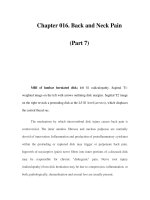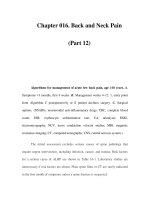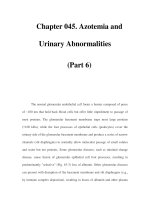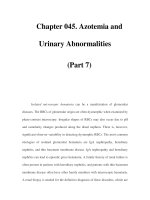Chapter 131. Diphtheria and Other Infections Caused by Corynebacteria and Related Species (Part 7) pdf
Bạn đang xem bản rút gọn của tài liệu. Xem và tải ngay bản đầy đủ của tài liệu tại đây (57.37 KB, 8 trang )
Chapter 131. Diphtheria and Other Infections Caused by
Corynebacteria and Related Species
(Part 7)
Other Nondiphtherial Corynebacteria
C. xerosis is a human commensal found in the conjunctiva, nasopharynx,
and skin. This nontoxigenic organism is occasionally identified as a source of
invasive infection in immunocompromised or postoperative patients and prosthetic
joint recipients. C. striatum is found in the anterior nares and on the skin, face, and
upper torso of normal individuals. Also nontoxigenic, this organism has been
associated with invasive opportunistic infections in severely ill or
immunocompromised patients. C. amycolatum is a new species isolated from
human skin and is identified on the basis of a unique 16S ribosomal RNA
sequence associated with opportunistic infection. C. glucuronolyticum is a new
nonlipophilic species that causes male genitourinary tract infections such as
prostatitis and urethritis. These infections may be successfully treated with a wide
variety of antibacterial agents, including β-lactams, rifampin, aminoglycosides, or
vancomycin; however, the organism appears to be resistant to fluoroquinolones,
macrolides, and tetracyclines. C. imitans has been identified in Eastern Europe as
a nontoxigenic cause of pharyngitis. C. auris has been isolated from children with
otitis media and is susceptible to fluoroquinolones, rifampin, tetracycline, and
vancomycin but resistant to penicillin G and variably susceptible to macrolides. C.
pseudodiphtheriticum (C. hofmannii) is a nontoxigenic component of the normal
human flora. Human infections—particularly endocarditis of either prosthetic or
native valves and invasive pneumonia—have been identified only rarely. Although
C. pseudodiphtheriticum may be isolated from the nasopharynx of patients with
suspected diphtheria, it is part of the normal flora and does not produce diphtheria
toxin. C. propinquum, a close relative of C. pseudodiphtheriticum, is part of CDC
Group ANF-3 and is isolated from human respiratory tract specimens and blood.
C. afermentans subspecies lipophilum belongs to CDC Group ANF-1 and has been
isolated from human blood and abscess infections. C. accolens has been isolated
from wound drainage, throat swabs, and sputum and is typically identified as a
satellite of staphylococcal organisms; it has been associated with endocarditis. C.
bovis is a veterinary commensal that has not been clearly identified as a cause of
human disease. C. aquaticum is a water-associated organism that is occasionally
isolated from patients using medical devices (e.g., for chronic ambulatory
peritoneal dialysis or venous access).
Rhodococcus
Rhodococcus species are phylogenetically related to the corynebacteria.
These gram-positive coccobacilli have been associated with tuberculosis-like
infections in humans with granulomatous pathology. Although R. equi is best
known, other species have been identified, including R. (also Gordonia)
bronchialis, R. (also Tsukamurella) aurantiacus, R. luteus, R. erythropolis, R.
rhodochrous, and R. rubropertinctus. R. equi has been recognized as a cause of
pneumonia in horses since the 1920s; it causes related infections in cattle, sheep,
and swine. R. equi is found in soil as an environmental microbe. The organisms
vary in length; appear as spherical to long, curved, clubbed rods; and produce
large, irregular mucoid colonies. R. equi does not ferment carbohydrates or liquefy
gelatin and is often acid fast. An intracellular pathogen of macrophages, R. equi
can cause granulomatous necrosis and caseation. The organism has been identified
most commonly in pulmonary infections, but infections of brain, bone, and skin
have also been reported. Most commonly, R. equi disease manifests as nodular
cavitary pneumonia of the upper lobe—a picture similar to that seen in
tuberculosis or nocardiosis. Most patients are immunocompromised, often with
HIV infection. Subcutaneous nodular lesions have also been identified. The
involvement of R. equi should be considered in any patient presenting with a
tuberculosis-like syndrome. Infection due to R. equi has been treated successfully
with antibiotics that penetrate intracellularly, including macrolides, clindamycin,
rifampin, and trimethoprim-sulfamethoxazole. β-Lactam antibiotics have not been
useful. The organism is routinely susceptible to vancomycin, which is considered
the drug of choice.
Actinomyces pyogenes
A cause of seasonal leg ulcers in humans in rural Thailand, A. pyogenes is a
well-known pathogen of cattle, sheep, goats, and pigs. A few human cases of
sepsis, endocarditis, septic arthritis, pneumonia, meningitis, and empyema have
been reported. The agent is susceptible to β-lactams, tetracycline,
aminoglycosides, and fluoroquinolones.
Arcanobacterium haemolyticum
A. haemolyticum was identified as an agent of wound infections in U.S.
soldiers in the South Pacific during World War II. This organism appears to be a
commensal of the human nasopharynx and skin but has been implicated as a cause
of pharyngitis and chronic skin ulcers. In contrast to the much more common
pharyngitis caused by Streptococcus pyogenes, A. haemolyticum pharyngitis is
associated with a scarlatiniform rash on the trunk and proximal extremities in
about half of cases; this illness is occasionally confused with toxic shock
syndrome. Because A. haemolyticum pharyngitis primarily affects teenagers, it has
been postulated that the rash-pharyngitis syndrome may represent copathogenicity
or synergy with EBV or opportunistic secondary infection complicating EBV
infection. A. haemolyticum has also been reported as a cause of bacteremia, soft
tissue infection, osteomyelitis, and cavitary pneumonia, predominantly in the
setting of underlying diabetes mellitus. The organism is susceptible to β-lactams,
macrolides, fluoroquinolones, clindamycin, vancomycin, and doxycycline.
Penicillin resistance has been reported.
Further Readings
Centers for Disease Control and Prevention: Availability of diphtheria
antitoxin through an investigational new drug protocol. MMWR 53:413, 2004
———
: Vaccine preventable deaths and the Global Immunization Vision
and Strategy, 2006–2015. MMWR 55:511, 2006
Dittmann S
et al: Successful control of epidemic diphtheria in the states of
the former Union of Soviet Socialist Republics: Lessons learned. J Infect Dis
181(Suppl 1):S10, 2000
Holmes RK: Biology and molecula
r epidemiology of diphtheria toxin and
the tox gene. J Infect Dis 181(Suppl 1):S156, 2000
Kadirova R
et al: Clinical characteristics and management of 676
hospitalized diphtheria cases, Kyrgyz Republic, 1995. J Infect Dis 181(Suppl
1):S110, 2000
Kretsinger K
et al: Preventing tetanus, diphtheria, and pertussis among
adults: Use of tetanus toxoid, reduced diphtheria toxoid, and acellular pertussis
vaccine; recommendations of the Advisory Committee on Immunization Practices
(ACIP) and recommendation of AC
IP, supported by the Healthcare Infection
Control Practices Advisory Committee (HICPAC), for use of Tdap among health-
care personnel. MMWR Recomm Rep 55(RR-17):1, 2006
MacGregor RR: Corynebacterium diphtheriae, in
Principles and Practice
of Infectious Diseases
, 6th ed, GL Mandell et al (eds). Philadelphia, Elsevier
Churchill Livingstone, 2005, pp 2457–2465
McNeil SA
et al: Comparison of the safety and immunogenicity of
concomitant and sequential administration of an adult formulation tetanus and
diphtheria toxoids adsorbed combined with acellular pertussis (Tdap) vaccine and
trivalent inactivated influenza vaccine
in adults. Vaccine 25:3464, 2007; Epub
2007 Jan 9.
Meyer DK, Reboli AC: Other coryneform bacteria and Rhodococcus, in
Principles and Practice of Infectious Diseases
, 6th ed, GL Mandell et al (eds).
Philadelphia, Elsevier Churchill Livingstone, 2005, pp 2465–2478
Pichichero ME et al: Combined tetanus, diphtheria, and 5-
component
pertussis vaccine for use in adolescents and adults. JAMA 293:3003, 2005 [PMID:
15933223]
Bibliography
Coyle MB, Lipsky BA: Coryneform bacteria in infectious diseases: Clinical
and laboratory aspects. Clin Microbiol Rev 3:227, 1990 [PMID: 2116939]
Galazka A: Implications of the diphtheria epidemic in the former Soviet
Union for immunization programs. J Infect Dis 181(Suppl 1):S244, 2000
Kneen R et al: Penicillin vs. erythrom
ycin in the treatment of diphtheria.
Clin Infect Dis 27:845, 1998 [PMID: 9798043]
Lipsky BA et al: Infections caused by nondiphtheria corynebacteria. Rev
Infect Dis 4:1220, 1982 [PMID: 6760340]
Love JF, Murphy JR: Corynebacterium diphtheriae: Iron-medi
ated
activation of DtxR and regulation of diphtheria toxin expression, in Gram-
Positive
Pathogens, VA Fischetti et al (eds). Washington, DC, ASM Press, 2000, pp 573–
582
Murray BE et al: Diphtheroid prosthetic valve endocarditis. A study of
clinical featu
res and infecting organisms. Am J Med 69:838, 1980 [PMID:
7446550]
Pappenheimer AM Jr, Murphy JR: Studies on the molecular epidemiology
of diphtheria. Lancet 2:923, 1983 [PMID: 6138500]

